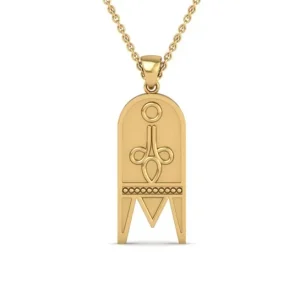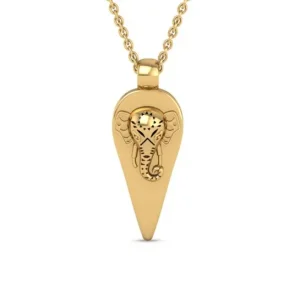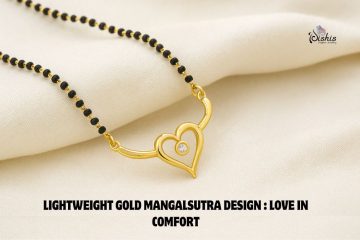Kerala ezhava thali designs has become one of the most cheered matrimonial traditions of Kerala, which is not just a decoration among people. This necklace represents the kind of medical devotion to the Ezhava community, which is considered to be one of the most notable and cultured in the land of Kerala. Through the centuries, Ezhava women have worn these beautiful thalies that show them married as part of depending on ancient traditions and have embraced contemporary aesthetics.
In order to comprehend the Ezhava Thali, one has to understand it more deeply into the race, caste, their tradition, and how they have been able to channelize their age-old customs according to the more and sensibilities. The guide covers the entire concept of the Kerala Ezhava Thali designs right down to the most spiritual meaning of them, to how they are interpreted today, so that a reader can realize the great heritage celebrated by the culture. These works signify.
About the Ezhava community and their heritage

The change over the centuries has been tremendous. The caste system, which was being marginalised in ancient Kerala, the Ezhava did reach the top after gaining education, social changes, and economic developments. This journey was greatly affected by the great social reformer called Shri Narayan Guru who was an Ezhava community social reformer and used to preach his message of one cast, one religion, one God to all humanity.
Trending sensibility in the Ezhava marriage tradition has always been the progressive way of the Ezhava matrimonial tradition. Although unchanging in their culture, the community has been receptive to changes and modernisation. This harmony between the past and the future finds a wonderful expression in changing the designs of the Ezhava Thali, which has not lost its original religious importance but has merged with modern designs.
The geographical placement of the Ezhava communities in Kerala has also added another aspect to the diversity of the Thali designs. In the north, to the sea-coast of Travancore in the South, the various regions have their own interpretation of the classical Thali and have come up with their own designs and styles, making a beautiful patchwork of patterns and styles.
The Ezhava communities’ geographical distribution across Kerala has also contributed to the diversity in Thali designs. From the Spice Garden of Malabar, in the north, to the coastal regions of Travancore in the South, different areas have developed their unique interpretations of the traditional Thali, creating a rich tapestry of designs and styles.
The Sacred Symbolism of Kerala Ezhava Thali Designs

BUY NOW
Spiritual Significance
Ezhava Thalli has surpassed its physical state to become a demonstrative spiritual representation. In the traditional opinions, the Thali is a veil or a shield of the married woman, protecting her against bad forces and evil. The gold incorporated in making it is regarded as pure and auspicious, expected to draw good vibration and sacred blessings
The semi or circular nature of the majority of traditional tall pendants symbolizes the cycle of life, the infinite nature of marriage, and the continuous connection between husband and wife. After it is blessed by the elders and priests in the wedding ceremony, the Thali is muddled with the spiritual power that is viewed to protect and involve the couple during their married life.
Cultural Meaning and Interpretation
Beyond spiritual aspects, the Thali carries Deep cultural meaning that has been passed down to generations. The act of trying the Thali known as Thali Kettal is perhaps the most significant moment in an Ezhava wedding ceremony. This ritual transformed to individual into a married couple, binding them, not just to each other, but their respective families and the broader community.
The designs incorporated into traditional Thali often tell stories of the communities and, heritage. Coconut leaf motif, for instance, reflects the communities ‘ historical connection to Coconut cultivation, floral patterns, particularly Lotus designs, symbolise purity, beauty, and spiritual awakening. The symbolic elements ensure that every Thali becomes a personal narrative of cultural identity and family heritage.
The designs incorporated into traditional Ezhava Thali often tell stories of the communities and, heritage. Coconut leaf motifs, for instance, replace the communities ‘ historical connection to Coconut cultivation. Floral patterns, particularly Lotus designs, symbolise purity, beauty, and spiritual awakening. These symbolic elements ensure that every Thali becomes a personal relative of cultural identity and family heritage.
Social Status and Recognition
Wearing a Thali immediately identifies a woman as married within Ezhava society, commanding respect and recognition. This visible symbol of matrimony has traditionally provided married women with a certain social status and protection within the community. The quality design and craftsmanship of a Thali often reflected the family, economic status, and social standing, through this aspect has become less pronounced in modern times.
Traditional Thali designs of Ezhavas
There are specific patterns in the traditional forms of Ezhava Thali which still have not changed much throughout the centuries. The simplest design is of an oval or circle in the center, which is made of pure gold and is called a central pendant. The average size of this pendant would be around 1.523 inches, but this may vary according to the preferences of the region and family history.
The front of the pendant is frequently wrought with complicated engraving or superimposed work. Typical themes are:
Paisley Pattern: Paisleys are supposed to be the representation of life and fertility. The mango pattern or the paisley is the one that is regarded as a symbol of abundance and prosperity in the local language.
Floral Engravings: Delicate flower patterns, especially Lotus and Jasmine motifs, are frequently incorporated. These flowers hold special significance in Hindu tradition, representing purity, beauty, and divine blessings.
Geometric designs: Geometric designs, the most basic and beautiful geometric patterns, concentric circles, diamond-like shapes, and linear ones, generate harmony and balance on sight.
Religious symbols: certain Thalis include religious symbols which are included very subtly, such as the Om symbol or Swastik, so as to relate to a spiritual aspect of the design.
The differences in the traditional designs across regions
The range of the Honey design in various areas of Kerala shows the mass presence and local impact of the community:
Northern Kerala: Thalis of this territory are more conservative in design, as they can be seen in slightly smaller dimensions with Philly inbuilt work. Malabar influence includes geometric designs and the application of traditional methods of goldsmithing, which were handed over from generations of local craftsmen.
This area, central Kerala, has a lovely effect of the combination of the traditional and Portuguese style, as Kochi was of value as a port of trade. Thali belongs to this region, but it tends to have a relatively bigger pendant with greater decorative work.
Southern Kerala: considered as being the most exuberant, Southern Kerala Thali is sometimes the most elaborate. They commonly have bigger pendants with much ornamental design, and this is based on the region and fiscal well-being of the past, as well as royal support of arts and crafts.
Chain Designs and Patterns
The chain of the Thali is an important part of it. Traditional chains come in several patterns:
- Rope Chain: twisted design that resembles a rope, providing strength and durability while maintaining elegance.
- Box Chain: connected for a smooth, flexible chain that lies flat against the neck.
- Curb Chain: oval links that are flattened and interlock, creating a sophisticated look
- Traditional Kerala chain: a unique design featuring small gold beads, interspersed with decorative elements, specific to Kerala’s jewellery-making tradition.
The wedding ceremony, Thali ritual
Pre-wedding preparation
The wedding of an Ezhava Thali starts long before the actual wedding. Family usually begins preparation on the Thali months before and usually visits various jewellery stores to get the perfect design. The process of selection is performed with close heed to the family traditions, personal desires of the bride, and astrological suggestions.
Traditional families will seek advice from the elders and Abnurb topics such as Astrology to choose the most auspicious facets in the design. Thalis of some families are inherited by generations, but still there are families who want to create new items that would charm by modern taste, but be keeping to the main principles.
Before the wedding is performed, the thali is normally blessed by the family temple or family priest. This blessing ritual (Thali Aasheervadam) is a prayer for the couple, joy and success, and long life towards the matrimonial relationship.
The Holy Ritual
Thali Kettal, the real Thali ceremony, is the most important part of the wedding. This ceremony is usually performed at the most accepted moment, which is calculated by means of astrology. It is a ceremony that proceeds through the following traditional steps:
Preparation Phase: Thali is put in a silver or brass dish, alongside other positive things such as rice, flowers, and sandalwood paste. The plate is held by the sister of the groom or a female member of his family.
Invocation: Prayers are offered to family duties and ancestors, seeking their blessings for the couple’s union. Vedic Mantras are chanted by the priest or family elders.
Moment: the grooms take the Thali with his right hand and places it around the bride’s neck. Traditionally, he ties it with three knots, each representing different aspects of their union: physical, mental, and spiritual harmony.
Community blessing: Family members and guests showered the couple with flowers, petals, and rice, offering their blessings and good wishes.
Changing Preferences and Lifestyle
Modern Ezhava women face different lifestyle demands compared to their grandmothers. Many work in a corporate environment, Travel frequently, or lead active lives that require more practical jewellery choices. This shift has led to significant innovation in Thali design, creating pieces that honour a tradition, culture, and culture while contemporary needs.
Today’s design often features the following:
- Lightweight construction, using hollow gold techniques or alternative materials for reducing weight without compromising appearance.
- Modular design: Thali with detachable elements can be modified for different occasions.
- Ergonomic considerations: designs that consider neck comfort, especially for long-term wear.
- Professional capability: styles that complement both traditional Indian wear and western business attire.
Contemporary Design Innovation
Modern jewellers and designers have introduced some innovations while respecting the traditional aesthetics.
- Minimalist approach: Clean, simple lines that capture the essence of traditional designs without elaborate ornamentation.
- Mixed metals design: Combining gold with white gold, rose gold, or platinum to create a contemporary colour contrast
- Gemstone integration: Incorporating diamonds, precious stones, or semi-precious stones for adding sparkle and colour.
- Convertible design: A Thali that can be worn as a regular necklace by removing or modifying certain elements.
- Personalisation options: Custom engraving, birthstone, inclusion, or a unique motif that reflects individual preferences.
Traditional materials
22K gold: the traditional choice of the Thali, 20 2K gold offers the perfect balance between purity and durability. It is a rich, warm colour and cultural significance. Make it the preferred option for most families.
18K gold: Increasingly popular for its durability and lower maintenance requirements, especially for daily wear pieces.
Hallmarked Gold: Modern consumers increasingly prefer hallmarked gold for assurance of purity and quality
Contemporary Material Options
- White gold: Offers a sophisticated, modern local while maintaining the prestige of gold
- Rose gold: Provides a unique, romantic appearance that complements various skin tones.
- Platinum: The ultimate luxury option, offering exceptional durability and prestige factor
- Gold-plated options: More affordable alternatives that provide the appearance of gold at a fraction of the cost.
Gemstone Addition
Modern Ezhava Thali often incorporates various gemstones:
- Diamonds added for sparkle and luxury, often in small accent settings.
- Rubies symbolise love and passion, popular for their vibrant colour
- Emerald represents growth and harmony, valued for their rich Green hue
- Pearl adds classic elegance and representing purity and wisdom
- Semi-precious stone includes Garnet, amethyst, and citrine for colour and affordability
Care and maintenance
Whenever we purchase something, the first thought that comes to mind is how much care it needs.
- Regular cleaning: Gentle cleaning with soft brushes and mild soap removes daily accumulation of dirt and oils.
- Proper storage: Using individual clothes, pouches, or jewellery boxes prevents scratching and tangling
- Chemical avoidance: Keeping the Thalli away from perfumes, lotion, and cleaning chemicals that can cause discoloration.
- Activity considerations: Removing the Thali during heavy physical work, exercise, or swimming to prevent damage.
Conclusion
Kerala ezhava thali designs is not just a matrimonial jewellery; in fact, it is a mark of tons of cultural heritage, spiritual belief, and community identity of centuries. Right back in the classical origins of Kerala to the contemporary twist in the modern way of life, the Thali has proved to be very strong and versatile.
Beauty with Thali tradition is the capability to respect the past and accept the future. Whether selecting an old-fashioned pattern which is linked to the customs of the past, or opting for a rather modern design that will take into account the modern aesthetics, the fundamental value remains the same.
The adaptation of these designs is part of a larger tale of Kerala culture, dynamism, and the progressive outlook of the Ezhava community. Considering the importance of such a tradition and letting it evolve in some way aesthetically, the tradition continues to appear relevant to future generations.
By selecting or being born as Ezhava Thali, the families are engaging in ongoing cultural practices that date back centuries and will still be doing so annually into the distant future as well. The Thali ones and the other contribute some part to the bigger picture of this heritage by themselves possessing individual and singular stories even though this is a pretty tradition that must live on, acquire significance, and be shared by everyone who has adopted it.



0 Comments